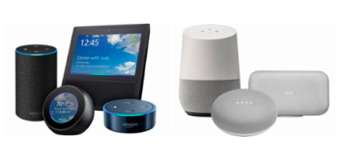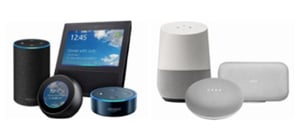How Voice Will Change the Way Consumers Shop Online | Salsify

 Voice search is just getting started. Over the past couple of year, digital assistants like Google Home and Amazon Alexa have turned themselves from a novelty into an essential feature for an increasing number of homes. They don't just tell jokes or play music; in addition, these speakers can adjust your thermostat, or help you shop online.
Voice search is just getting started. Over the past couple of year, digital assistants like Google Home and Amazon Alexa have turned themselves from a novelty into an essential feature for an increasing number of homes. They don't just tell jokes or play music; in addition, these speakers can adjust your thermostat, or help you shop online.
Chief among them might be e-commerce. Almost one-third of all Alexa and Home users shop through their device, and another 41 percent plan to do so in the future. To build a successful long-term strategy for your online business, you must account for this coming wave of voice-based online shoppers.
How can you accomplish that feat? The first step includes understanding how voice is already changing the way consumers shop online. With this understanding in hand, you can make strategic adjustments that prepare your business for the future that lies ahead.
Trend 1: Search Engine Optimization for Voice-Powered Shopping
The first trend might also be the most obvious. Simply put, internet users who browse the internet using voice behave differently than those typing in words on a keyboard. Considering that most e-commerce traffic tends to originate from sites like Google and Bing, this search engine optimization (SEO) trend is worth monitoring for any online merchant.
In a post earlier this year, Search Engine Land broke down the nuances of voice search. They're too in-depth to explain in detail here, but include:
- More visibility in featured snippets on search engine results pages.
- More consideration of context to meet searcher demand and intent.
- More natural search terms that are full sentences or questions rather than keyword-heavy.
Marketing research firm ComScore predicts that by 2020, half of all online searches will be via voice. To continue to be found for potential shoppers, your website and product pages have to account for that fact.
Trend 2: The Increased Ease and Importance of Product Reviews
The increase of online browsing via voice, of course, goes beyond simply searching for your product or product category. In addition, it has also elevated the importance of online reviews for your products or services. As AdWeek predicts, the emergence of voice can lead to a more effective feedback loop between merchant and customer:
Imagine you order a jacket that you love but you never get around to filling out reviews online. In your next daily briefing, your voice assistant asks you: "How would you rate your Nano Puff jacket from one to five stars? Did it fit as you expected?" It's probably worth your time to answer one or two quick questions, especially if you'll get better recommendations as a result.
In other words, online reviews will become more representative. But they'll also rise in importance. Almost 85 percent of voice-based shoppers trust recommendations from their virtual assistants. These recommendations, of course, are based on top-reviewed products in the query. Highlighting your reviews, particularly in comparison to your competition, will be more important than ever before.
Trend 3: Tracking the Sale and Shipping Through its End Point
In a few years, the most common voice prompt may not actually be a product order or product review. Instead, it will probably come down to quick updates on shipping status, as well as potential returns. These formerly complex processes need to become significantly more intuitive in an age when your audience expects instant, productive responses.
As AdWeek points out, some retailers have begun to integrate return reminders into their voice shopping offers. After a few days, your assistant can simply remind you to return unused products. But of course, your business model and operation must be built with this type of functionality in mind.
On an even simpler level, it makes sense to connect your shipping operations directly to a voice app. Your audience should be able to track their package using nothing more than a voice command. If they can, the possibilities and convenience of the medium could give you a crucial competitive advantage.
Trend 4: Default Loyalty Through Convenient Re-Orders
Countless words have been written about the decline of brand loyalty. Through voice search, we may begin to see a resurgence - albeit not necessarily a willing one. The easier you make it for your customers to re-order a product, the more likely they will be to stay with you.
Think about it from a consumer view. If you've been reasonably happy with a product, would you really go out to find another alternative if you could re-order with a simple command? The answer should be obvious. In voice search, convenience is key, and you can provide that convenience if you build your e-commerce infrastructure the right way.
That includes not just opening the re-order process similar to Amazon's one-click approach, but also setting up reminders. Analytics software can find buying trends, especially for convenience products. Once you're at the end of a cycle, you can set up a reminder for your audience to re-order. You'll get almost natural retention and loyalty, out of pure convenience.
Trend 5: Unsolved Obstacles in Voice-Based Shopping
Voice search and shopping is here to stay, but that doesn't mean it's flawless. Instead, as USA Today points out, several obstacles do still exist in this environment that make it difficult for both merchants and consumers to adjust:
- Comparing products and prices can be difficult, making the technology ineffective so far for complex purchases.
- The average voice order value is significantly lower than its web-based counterpart, suggesting fewer bundling decisions by consumers.
- Many users still don't trust that without choice, their assistant will pick the right product for them based on their query.
Despite these obstacles, one thing is clear: voice-based search and consumer behavior has the potential to change e-commerce as we know it. As a majority of consumers switches to this methodology, it's on retailers to accommodate their changing needs. Failure to do so could result in falling behind your fast-adjusting competition.
Are you ready for that switch? How are you accommodating the already-substantial portion of consumers shopping via their voice assistants today? Build a repeatable process to deliver the right content, when and where consumers need it, and you will drive purchases and build trust. Product experience management, across every sales channel, is how brands repeatedly win. 
Written by: Cara Wood
Cara Wood (she/her) is a writer and former director of brand journalism at Salsify, where she specialized in creating content to help brands excel in ecommerce. Her work has helped organizations enhance their digital shelf and product experience management strategies.
Recent Posts
What the Data Says About Consumer Interest in AI Shopping Agents
How Retailers Can Use Geolocation To Create Personalized Shopping Experiences
3 Examples of a Personalized Shopping Experience and How To Create Them
Subscribe to the Below the Fold Newsletter
Standing out on the digital shelf starts with access to the latest industry content. Subscribe to Below the Fold, our monthly content newsletter, and join other commerce leaders.


.svg)